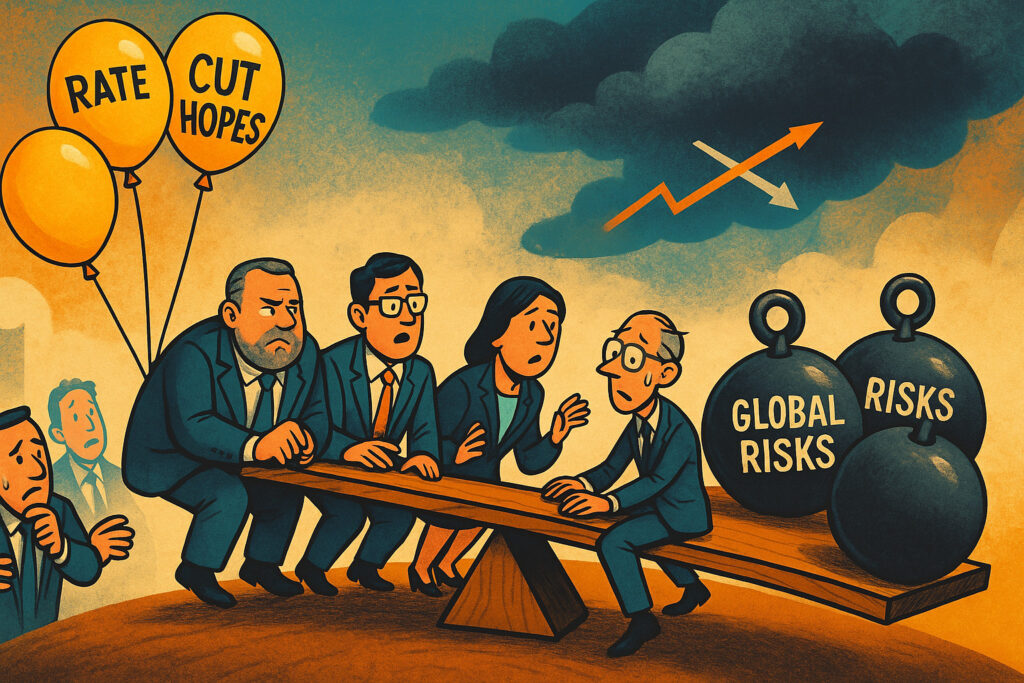Introduction
On 24 August 2025, global markets took a more measured stance following the prior session’s surge driven by anticipated Federal Reserve rate cuts. Asian equities rose modestly, buoyed by dovish signals from Jackson Hole, while U.S. and European futures pulled back slightly as rate‑cut enthusiasm stabilized. Meanwhile, Gulf markets rallied, powered in part by regional developments and currency sensitivities. In India, analysts eyed potential positive spillovers from U.S. monetary shifts—but caution prevailed amid broader uncertainties. This environment reflected a transition from exuberance to equilibrium, as investors repositioned in response to evolving central bank forward guidance.
Global Markets Back to Balanced Waters
U.S. and European equity futures moderated amid retreating inflation and rate‑cut euphoria, suggesting markets were cooling from last week’s momentum . The pullback in sentiment signals a broader shift—markets are reassessing the likelihood and timing of Fed easing, moving from aggressive positioning to more nuanced expectations.
Conversely, Asian markets opened higher, aligning with signals of imminent Federal Reserve easing. The traction in equities across the region reflected investor conviction that rate cuts are now a near‑term certainty, helping to underpin capital flows .
Gulf Markets Ride Rate-Cut Tailwinds
Gulf-region equities benefited sharply from the changing U.S. monetary outlook. Most Gulf markets closed higher, with Saudi Arabia’s index rising 0.4%, buoyed by a 0.7% gain in Aramco. ACWA Power also outperformed, gaining 1.6% following news of substantial financing for new power plant projects. Egypt’s EGX30 added 0.5%, helped by strong performance in Eastern Company shares. Qatar bucked the trend slightly, dipping 0.2% due to a decline in its leading bank’s equity .
These moves underscore how closely Gulf assets track U.S. rate expectations—especially in countries peg-locked to the dollar—turning central bank signals into tangible regional flows.
Rate-Cut Odds Strengthen
Market pricing increasingly reflects confidence in upcoming rate easing. The probability of a September cut eclipsed 85%, with consensus expecting at least two quarter-point trimming moves by year-end. These expectations arise from growing concern over the labor market, even as inflation shows signs of deceleration .
If realized, rate reductions could further support equities and risk assets—but also signal underlying weakness in the economic outlook. Investors remain alert to the balance between relief and recession risk.
Analysts Point to Global Growth Headwinds
At the ET World Leaders Forum, global economists flagged rising trade policy risks—especially tariffs—as emerging threats to economic stability. Experts cautioned that prolonged uncertainty may force companies to rethink supply-chain strategies and delay investments, with long-term implications for global equities and trade-sensitive sectors .
These concerns temper the mood of the week, reminding markets that monetary policy shifts occur amid expanding geopolitical and structural disruptions.
Sentiment Shifts Toward Cautious Optimism
Collectively, the developments on August 24 reflect a delicate rebalancing of market psychology:
- From euphoria to reflection: Rate-cut optimism remains in play, but buying fervor is giving way to selective caution.
- Global divergence grows: While Asian markets hold steady gains, U.S. and European equities are more calculated.
- Currency-linked flows matter: Gulf markets’ sensitivity to dollar-pegged vulnerabilities showcases how structural regional exposure magnifies U.S. policy impact.
- Policy risks persist: Tariff and trade concerns lurk, reminding investors that macro relief does not immunize from geostrategic shocks.
Conclusion
The 24 August 2025 session marks a turning point from unchecked bullish momentum toward a more calibrated market stance. While central bank signals continue to shape near-term prospects, investors face increasingly complex terrain, where growth projections, geopolitical risk, and policy uncertainties interact dynamically.
Key questions ahead:
- Will upcoming economic data validate accelerated rate-cut expectations—or trigger renewed caution?
- Do regional disparities, such as those evident in Gulf markets, signal broader imbalances in global asset flows?
- How consequential will trade policy and tariff dynamics remain, even amid central bank easing?
As markets brace for strategy shifts, August 24 underscores a market in pause—not retreat—standing guard at the crossroads of optimism and caution.
